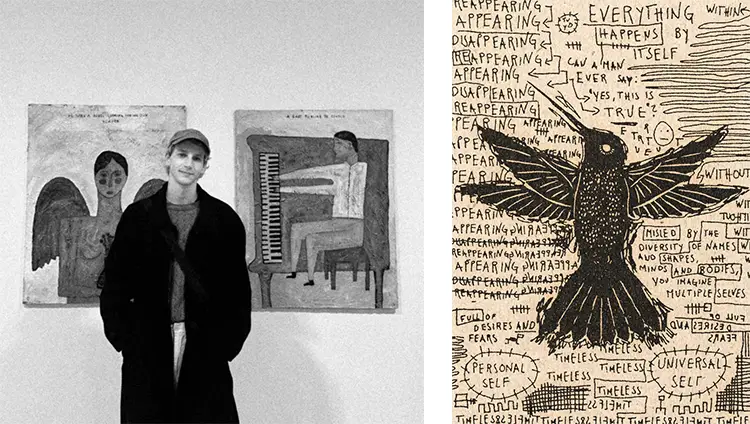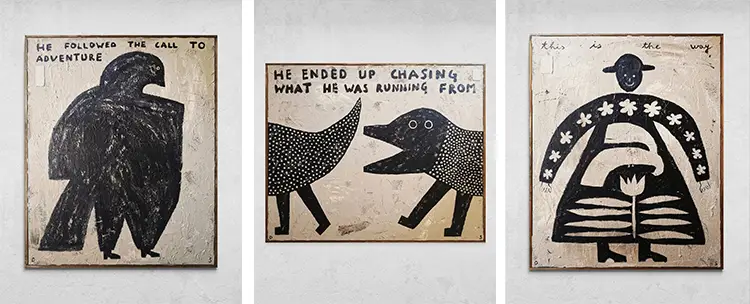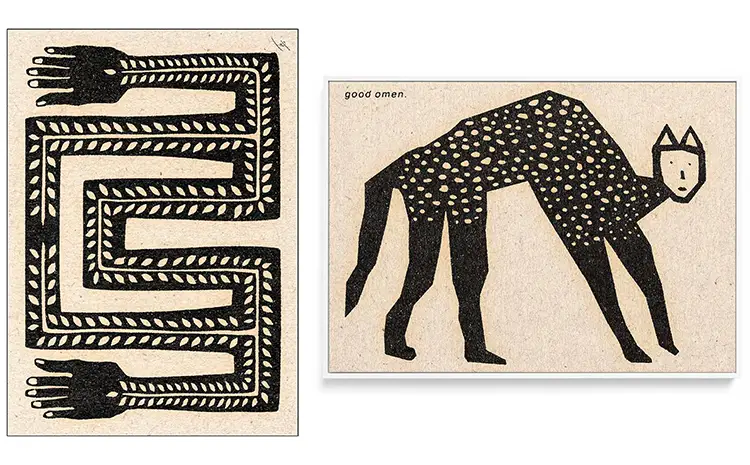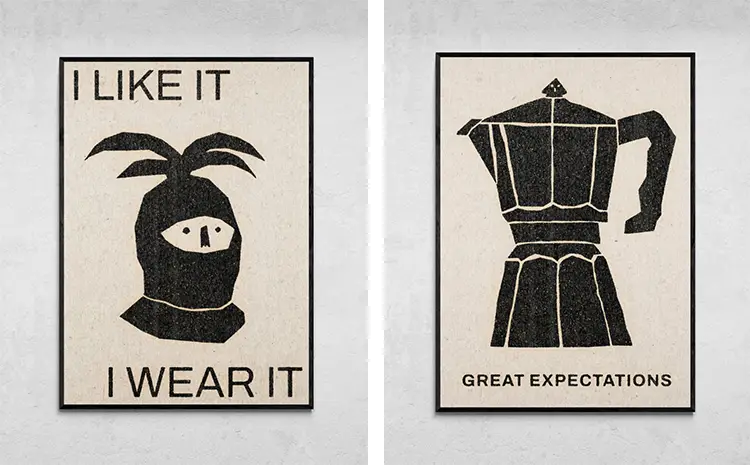Symbols, Silence, and the Pulse of Creation
David Schmitt, better known by the name Tuyo, is rapidly establishing himself as a distinctive voice in contemporary art, crafting an aesthetic that merges the archaic with the digital, the instinctive with the designed. Born in 1994 in Bamberg, Germany, Schmitt’s work is arresting in its blend of folk sensibilities, graphic playfulness, and a stripped-back visual language. Whether it’s a linocut print on archival paper or a cryptic digital poster, his creations invite viewers into an open-ended dialogue that feels both personal and ancient. With over 63,000 followers on Instagram and a steady stream of admirers worldwide, Schmitt is redefining the value of imperfection and immediacy in a world saturated with polished, overproduced images.
Interestingly, Schmitt’s path into art wasn’t predetermined. His creative journey began just four years ago, not from formal ambition, but from a deep personal shift—an impulse to reconnect with something innate. Despite a background in graphic design from the University of Applied Sciences in Augsburg, he resisted the slick, commercial visual language typically associated with that discipline. Instead, he sought something rougher, something more emotive and irregular. His early experiments were rooted in trial, error, and a growing trust in intuition. That choice to step away from a rigid framework and into a freer, self-taught approach catalyzed the development of the unique visual dialect that would come to define Tuyo.
The name Tuyo itself emerged with the same spontaneity that characterizes Schmitt’s entire process. Chosen for its resonance rather than its literal meaning, the Spanish word for “yours” became an unintentional yet fitting emblem of his artistic philosophy. Each piece, while undeniably born of his hand, feels offered to the viewer—a quiet, visual gift without definitive instructions. This sense of mutual ownership, where meaning is co-authored by both artist and observer, underscores the openness at the heart of his work. There’s a palpable generosity in this gesture: a willingness to let go of control and allow others to complete the picture.

David Schmitt: Art as Archetype and Echo
Much of Schmitt’s art seems to reach backward even as it speaks to the present. His figures—flowers with eyes, bears with blank stares, birds with too many toes—are not direct observations from life, but symbols pulled from some shared human memory. Their simplicity belies their weight; they function like pictographs that have survived some mythical collapse. This instinctive use of recurring characters helps Schmitt tap into something communal, crossing barriers of language and geography to explore our universal strangeness. He refers to them as emotional stand-ins—echoes of what we all carry within, expressed through images that defy linear meaning.
His inspiration draws heavily from folkloric traditions and artisanal craft, yet it also nods to outsiders and autodidacts like William Traylor, whose works resonate with raw immediacy and an uncanny sense of personality. Schmitt admires artists who create from necessity, not curriculum—people who prioritize instinct over theory. The same can be said for his relationship to text. Phrases like “the easy way is easy” or “it makes no sense but it does” often accompany his visuals, forming cryptic, haiku-like fragments. These lines are sourced from a personal archive—quotes, lyrics, overheard conversations—that strike him for reasons he doesn’t always understand. Meaning is not dictated; it’s discovered.
This fluidity between word and image, order and randomness, shapes a visual language that embraces contradiction. His pieces rarely offer resolution. Instead, they prompt a kind of quiet contemplation, encouraging viewers to sit with ambiguity. For Schmitt, ambiguity is not a weakness to be clarified but a strength to be protected. It allows for infinite readings, welcoming every viewer to bring their own context and memory into the encounter. This inclusive approach makes his work not only visually striking but emotionally resonant, cultivating a space where questions are more valuable than answers.

Of Ink and Immediacy: Between Hand and Screen
Schmitt’s practice lives at the intersection of analog and digital, blending ancient methods with modern tools in ways that feel seamless rather than dichotomous. On one side of his studio, he might be carving linoleum blocks and pressing them onto archival paper—a process that connects him physically to the work through resistance, pressure, and touch. On the other side, he might be designing a poster on his tablet, layering digital textures that mimic the inconsistencies of print. He sees these approaches not as conflicting but as complementary. Each offers something the other cannot, and their interplay keeps his process both grounded and expansive.
He’s particularly drawn to monochromatic palettes, finding liberation in limitation. By stripping away color, he forces attention onto form, contrast, and spatial relationships. This reduction sharpens the emotional clarity of the work and aligns with his broader ethos: that the most honest communication often comes from what is left unsaid. If an image can evoke wonder or recognition in a single hue, then color becomes secondary, almost ornamental. This minimalist approach aligns with his view that storytelling should be intuitive, not decorative—an act of distillation rather than embellishment.
Despite being unaffiliated with any formal gallery, Schmitt maintains a steady rhythm of production and collaboration. Working independently allows him full creative freedom, something he values deeply. He has partnered with brands like Minimum Wines to create unique label designs, and he continues to expand his output without losing the essence of his vision. Whether using hand tools or digital software, his core principle remains unchanged: to make art that preserves something essential about being human. This duality—between ancient technique and contemporary context—imbues his work with a sense of continuity that feels both timely and timeless.

David Schmitt: The Quiet Rebellion of Childlike Vision
Central to Schmitt’s aesthetic philosophy is a desire to see through the eyes of a child—not in terms of naiveté, but through a lens of open curiosity. He believes this mode of perception offers an antidote to the adult world’s constant striving for perfection and clarity. In his practice, embracing the crooked, the awkward, and the unfinished becomes a form of quiet rebellion. It’s a way to return to a more instinctive mode of expression, where things don’t have to make sense to carry meaning. This outlook is reflected in the skewed shapes, unbalanced compositions, and surreal characters that populate his work.
Rather than correcting these imperfections, Schmitt amplifies them. The irregular becomes deliberate. His work resists polish in favor of rawness, echoing the aesthetic sensibilities found in prehistoric markings or outsider art. There’s a poetic sensibility at play, where even nonsense contains wisdom, and ambiguity becomes a tool for empathy. He invites viewers into a dream-state—one that is neither rational nor entirely abstract, but something in between. It’s a liminal space where meaning is felt rather than explained, and where emotion takes precedence over logic.
Looking ahead, Schmitt continues to explore new media while staying grounded in his visual lexicon. Acrylics and oil pastels have recently entered his toolkit, bringing more color into his world without disrupting its internal logic. Yet his focus remains the same: to create art that reconnects people to forgotten parts of themselves. His work is not a mirror of society, but a window into something older, deeper, and slower. In a world increasingly driven by speed and spectacle, David Schmitt offers a different rhythm—one rooted in intuition, silence, and the power of primitive mark-making to say what words often cannot.








